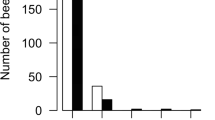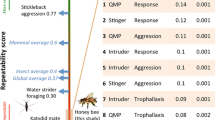Summary
Worker honey bees proceed through a sequence of tasks, passing from hive and guard duties to foraging activities. When presented with moderate demographic alterations in colony age structure, bees may work harder at some tasks but do not significantly alter median ages of task performance for many behaviour patterns. This is in contrast to other studies that have presented colonies with more drastic demographic stresses (i.e., removal of most or all old and/or young workers) and which have demonstrated dramatic changes in the ages of task performances. The additional efforts invoked by demographic manipulations are consistent with a viewpoint that considers honey bee colonies to be resilient rather than maximally efficient systems.
Zusammenfassung
Mit zunehmendem Alter durchlaufen die Arbeiterinnen der Honigbiene in gesetzmässiger Reihenfolge ihre Tätigkeiten: sie gehen von der Brutpflege zum Bauen, dann zur Sammeltätigkeit über. Wenn man den Arbeitsmarkt künstlich, aber nur mässig stört, dann passen sich die Bienen dadurch an, dass sie einige Tätigkeiten intensiver ausführen, ohne dass dabei aber das mittlere Alter für diese Tätigkeit geändert wird. Dies steht im Gegensatz zu anderen Untersuchungen, wo der Arbeitsmarkt drastisch gestört wurde, z. B. durch Entfernung der meisten oder aller alten oder jungen Arbeiterinnen. Durch solchen drastischen demographischen Stress wurde eine Umstellung in der Altersstufe für bestimmte Tätigkeiten erwirkt. Die in dieser Arbeit durchgeführten demographischen leichten Manipulationen lassen den Schluss zu, dass der Bienenstaat bei verschiedenen Anforderungen an den Arbeitsmarkt durchaus plastisch beweglich ist, aber nicht maximal sich umstellen kann.
Similar content being viewed by others
References
Altmann J., 1974. — Observational study of behavior: sampling methods.Behaviour, 49, 227–267.
Altmann J., 1984. — Observation sampling methods for insect behavioral ecology.Fla. Entomol., 67, 50–56.
Bodenheimer F.S., 1937. — Studies in animal populations. II. Seasonal population trends of the honey-bee.Q. Rev. Biol., 12, 406–425.
Butler C.G., Free J.B., 1952. — The behaviour of worker honeybees at the hive entrance.Behaviour, 4, 262–292.
Eischen F.A., Rothenbuhler W.C., Kulincevic J.M., 1982. — Length of life and dry weight of worker honeybees reared in colonies with different worker-larva ratios.J. Apic. Res., 21, 19–25.
Free J.B., 1961. — Hypopharyngeal gland development and division of labour in honey bee (Apis mellifera L.) colonies.Proc. R. Entomol. Soc. Lond. (A), 36, 5–8.
Haydak M.H., 1932. — Division of labor in the colony.Wisc. Beekeeping, 8, 36–39.
Himmer (A.), 1930. — Von der Arbeitsteilung im Bienenstaat.Leipzig, Bienenztg, 45, 39–43, 64–67.
Jeffree E.P., 1955. — Observations on the decline and growth of honeybee colonies.J. Econ. Entomol., 48, 723–726.
Kolmes S.A., 1984. — A quantitative comparison of observational methodologies for studies of worker honeybees.J. Apic. Res., 23, 189–198.
Kolmes S.A., 1985a. — A quantitative study of the division of labour among worker honey bees.Z. Tierpsychol., 68, 287–302.
Kolmes S.A., 1985b. — An ergonomic study ofApis mellifera (Hymenoptera: Apidae).J. Kans. Entomol. Soc., 58, 413–421.
Kolmes S.A., 1986a. — Age polyethism in worker honey bees.Ethology, 71, 252–255.
Kolmes S.A., 1986b. — Have hymenopteran societies evolved to be ergonomically efficient?J. New York Entomol. Soc., 94, 447–457.
Kolmes S.A., Winston M.L., 1986. — A quantitatives method for assessing some aspects of the independence of sampling in behavioural studies of worker honey bees.J. Apic. Res., 25, 209–212.
Lindauer M., 1952. — Ein Beitrag Zur Frage der Arbeitsteilung im Bienenstaat.Z. vergl. Physiol., 34, 299–345.
Milojevic B.D., 1940. — A new interpretation of the social life of the honeybee.Bee World, 21, 39–41.
Nelson F.C., 1927. — Adaptability of young bees under adverse conditions.Am. Bee J., 67, 242–243.
Ribbands C.R., 1952. — Division of labour in the honeybee community.Proc. Roy. Soc. London (B), 140, 32–43.
Rösch G.A., 1925. — Untersuchungen über die Arbeitsteilung im Bienenstaat. I. Teil: Die Tätigkeiten im normalen Bienenstaate und ihre Beziehungen zum Alter der Arbeitsbeinen.Z. vergl. Physiol., 2, 571–631.
Rösch G.A., 1927. — Uber die Bautätigkeit im Bienenvolk und das Alter der Baubienen. Weiterer Beitrag zur Frage nach der Arbeitsteilung im Bienenstaat.Z. vergl. Physiol., 6, 265–298.
Rösch G.A., 1930. — Untersuchungen über die Arbeitsteilung im Bienenstaat. II. Teil: Die Tätigkeiten der Arbeitsbienen unter experimentall veränderten Bedingungen.Z. vergl. Physiol., 12, 1–71.
Sakagami S.F., 1953a. — Untersuchungen über die Arbeitsteilung im einem Zwergvolk der Honigbiene. Beiträge zur Biologie des Bienenvolkes,Apis mellifera L. I.Jpn. J. Zool., 11, 117–185.
Sakagami S.F., 1953b. — Arbeitsteilung der Arbeiterinnen in einem Zwergvolk, bestehend aus gleichaltrigen volksgenossen. Beiträge zur Biologie des Bienenvolkes,Apis melifera L. II.J. Fac. Sci. Hokkaido Univ. Ser VI Zool, 11, 343–400.
Seeley T.D., 1982. — Adaptive significance of the age polyethism schedule in honeybee colonies.Behav. Ecol. Sociobiol., 11, 287–293.
Seeley T.D., 1986. — Division of labour among worker honeybees.Ethology, 71, 249–251.
Sekiguchi K., Sakagami S.F., 1966. — Structure of the foraging population and related problems in the honeybee, with consideration on the division of labour in bee colonies.Hokkaido Agr. Exp. Sta. Report, 69, 1–65.
Siegel S., 1956. — Nonparametric Statistics for the Behavioral Sciences.McGraw-Hill, Toronto and New York, 312 p.
Winston M.L., 1979. — Intra-colony demography and reproductive rate of the Africanized honeybee in South America.Behav. Ecol. Sociobiol., 4, 279–292.
Winston M.L., 1980. — Seasonal patterns of brood rearing and worker longevity in colonies of the Africanized honey bee (Hymenoptera: Apidae) in South America.J. Kans. Entomol. Soc., 53, 157–165.
Winston M.L., Dropkin J.A., Taylor O.R. 1981. — Demography and life history characteristics of two honey bee races (Apis mellifera).Oecologia (Berlin), 48, 407–413.
Winston M.L., Fergusson L.A., 1985. — The effect of worker loss on temporal caste structure in colonies of the honeybee. (Apis mellifera L.).Can. J. Zool., 63, 777–780.
Winston M.L., Fergusson L.A., 1986. — The influence of the amount of eggs and larvae in honey bee (Apis mellifera L.) colonies on temporal division of labour.J. Apic. Res., 25, 238–241.
Winston M.L., Katz S.J., 1981. — Longevity of cross-fostered honey bee workers (Apis mellifera) of European and Africanized races.Can. J. Zool., 59, 1571–1575.
Winston M.L., Katz S.J., 1982. — Foraging differences between cross-fostered honeybee workers (Apis mellifera) of European and Africanized races.Behav. Ecol. Sociobiol., 10, 125–130.
Winston M.L., Punnett E.N., 1982. — Factors determining temporal division of labour in honeybee.Can. J. Zool., 60, 2947–2952.
Author information
Authors and Affiliations
Rights and permissions
About this article
Cite this article
Kolmes, S.A., Winston, M.L. Division of labour among worker honey bees in demographically manipulated colonies. Ins. Soc 35, 262–270 (1988). https://doi.org/10.1007/BF02224059
Received:
Accepted:
Issue Date:
DOI: https://doi.org/10.1007/BF02224059




